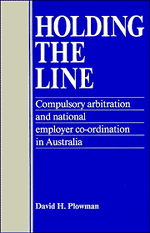Book contents
- Frontmatter
- Contents
- List of tables and figures
- List of abbreviations
- Acknowledgements
- Introduction
- Dedication
- 1 Industrial legislation and the rise of permanent employer associations 1890–1906
- 2 The Higgins era 1907–1920
- 3 Rival shops 1921–1929
- 4 Depression and recovery 1930–1939
- 5 War and government executive action 1940–1949
- 6 Consolidation 1950–1959
- 7 The National Employers' Associations 1960–1972
- 8 Confederation 1973–1988
- 9 Models of national employer co-ordination
- Appendices
- Bibliography
- Records of organisations
- Index
8 - Confederation 1973–1988
Published online by Cambridge University Press: 05 November 2011
- Frontmatter
- Contents
- List of tables and figures
- List of abbreviations
- Acknowledgements
- Introduction
- Dedication
- 1 Industrial legislation and the rise of permanent employer associations 1890–1906
- 2 The Higgins era 1907–1920
- 3 Rival shops 1921–1929
- 4 Depression and recovery 1930–1939
- 5 War and government executive action 1940–1949
- 6 Consolidation 1950–1959
- 7 The National Employers' Associations 1960–1972
- 8 Confederation 1973–1988
- 9 Models of national employer co-ordination
- Appendices
- Bibliography
- Records of organisations
- Index
Summary
The previous chapter reviewed developments in the period from 1960 when the National Employers' Associations (NEA) came into being, to 1972, when post-war Coalition rule ended. 1972 is also associated with the formation of the Central Industrial Secretariat by the merger of the ACMA's industrial relations division with the ACEF's national secretariat. Though the NEA maintained many of the voluntaristic elements of the previous co-ordinating machinery, it had a formal constitution. Further, its two committees, the National Employers' Policy Committee and the National Employers' Industrial Committee, had a wider mandate than their predecessors. The formation of the NEA resulted in a high degree of employer unity and the successful execution of the ‘total wage’ campaign. The new total wage environment, however, led to metal industry employers seeking the removal of the centralised wages system. This threatened the rationale of the NEA as well as the dominance of umbrella organisations such as the ACEF and the ACMA. It also resulted in major divisions within the NEA.
This chapter reviews national employer developments in the period from 1973 to 1980. It was during this period that a confederation, which subsumed the functions of the NEA, was finally brought into existence. Unlike the Confederation of Employers advocated by the ACEF and opposed by the ACMA in the earlier periods, however, the Confederation of Australian Industry (CAI) followed the British model and included a trade wing.
- Type
- Chapter
- Information
- Holding the LineCompulsory Arbitration and National Employer Co-ordination in Australia, pp. 172 - 205Publisher: Cambridge University PressPrint publication year: 1989



